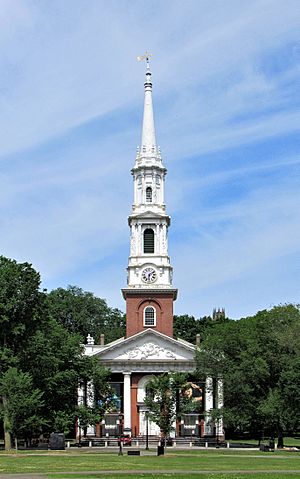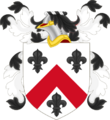John Dixwell facts for kids
Quick facts for kids
John Dixwell, alias James Davids
|
|
|---|---|

Center Church on the Green, New Haven, Connecticut; its cemetery includes Dixwell's monument
|
|
| Member of Parliament for Dover |
|
| In office Long Parliament August 1646 to April 1653 (dissolved); reseated May 1659, dissolved March 1660 – Third Protectorate Parliament January to April 1659 |
|
| Member of Parliament for Kent |
|
| In office 1654–1658 |
|
| Governor of Dover Castle | |
| In office January 1652 – May 1660 |
|
| English Council of State | |
| In office November 1651 to October 1652 – May to December 1659 |
|
| Personal details | |
| Born | c. 1607 Chilvers Coton, Warwickshire |
| Died | 18 March 1689 New Haven, Connecticut |
| Resting place | Center Church on the Green |
| Nationality | English |
| Spouses | (1) Joanna Ling (November 1673) (2) Bathsheba Howe (1677–his death) |
| Children | (2) Mary; John; Elizabeth |
| Alma mater | Lincoln's Inn |
| Military service | |
| Allegiance | Parliamentarian |
| Rank | Colonel |
| Unit | Kent Trained Bands |
| Battles/wars | |
John Dixwell, also known as James Davids, was an English lawyer and politician. He was born around 1607 and died on March 18, 1689. During the Wars of the Three Kingdoms (a series of conflicts in England, Scotland, and Ireland), he worked for the Parliament in Kent.
Dixwell was one of the people who approved the execution of King Charles I in January 1649. After the king's death, England became a republic called the Commonwealth. Dixwell served as the Governor of Dover Castle and was part of the English Council of State, which helped run the country.
When the monarchy was restored in May 1660, Dixwell knew he would likely be punished for his role in the king's execution. He fled to Germany and later moved to New Haven, Connecticut. There, he lived quietly under the name "James Davids" and was not bothered by the authorities, who thought he had died. He passed away in 1689.
Contents
Who Was John Dixwell?
John Dixwell was born around 1607. His parents were Edward Dixwell and Mary Hawksworth. He had an older brother named Mark, who died in 1644 while fighting for Parliament.
After his father died in 1617, John and his brother were likely raised by a wealthy relative, Sir Basil Dixwell. Sir Basil was a former High Sheriff of Kent and lived near Folkestone. John Dixwell started studying law at Lincoln's Inn in 1631 and became a lawyer in 1638.
Family Life in New England
After moving to the New England region of America, John Dixwell married Joanna Ling in November 1673. Sadly, she died soon after. In 1677, he married his second wife, Bathsheba Howe. They had three children: Mary (born 1679), John (born 1681), and Elizabeth, who died when she was young.
Dixwell's Role in the English Civil War
The First English Civil War began in August 1642. The county of Kent quickly came under the control of Parliament. However, there were still many people in Kent who supported the King.
Kent was very important because it was close to London and had key ports like Dover and Deal. Controlling Kent was a major goal for both sides in the war.
John Dixwell became an important figure in the local Parliament government. He served on the County Committee, which was in charge of collecting taxes and managing the courts. His older brother Mark was a colonel in the local army (the Kent Trained Bands). When Mark died in 1644, John became the guardian of his children. He also took over Mark's role as colonel of the local militia.
In August 1646, John Dixwell was elected as a MP for Dover.
The Second English Civil War
The First Civil War ended in June 1646 when King Charles I surrendered. But after the war, there were disagreements between the army and most Members of Parliament about how to govern the country. Dixwell seemed to agree with the army and the religious Independents in Parliament.
In December 1647, protests in Canterbury against changes to church services turned into a revolt supporting the King. This uprising was eventually stopped by the County Committee.
The Second English Civil War started in early 1648. Royalist supporters in Kent took over towns like Maidstone and Dover. By August, this uprising was also put down. Many Independents, like Dixwell, now believed that the fighting would only stop if King Charles I was removed from power.
In December 1648, an event called Pride's Purge removed all MPs who did not want to put the King on trial. Dixwell was one of the MPs who kept his seat. He was part of the court that tried King Charles I and approved the King's execution in January 1649.
Life During the Commonwealth
After the King's execution, England became a republic. Dixwell was made a member of the English Council of State in November 1651. In January 1652, he was confirmed as the Governor of Dover Castle.
However, his closest political friends were republicans who did not agree with Oliver Cromwell when he dissolved Parliament in April 1653 and set up his own government, called The Protectorate. Unlike some of his friends, Dixwell did not openly oppose Cromwell's rule. He was elected as an MP for Kent in 1654 and 1656, and then again for Dover in 1659.
The End of the Commonwealth
After Oliver Cromwell died in September 1658, and his son Richard Cromwell resigned in April 1659, Dixwell supported those who wanted to bring back the Commonwealth and have civilian control over the army. When Parliament was re-established in May 1659, he returned as an MP for Dover. He was also confirmed as Governor of Dover Castle and appointed to the Council of State.
By spring 1660, it was clear that the Commonwealth could not last. The return of the monarchy, known as the Stuart Restoration, was about to happen. In May, King Charles II offered a general pardon for most "crimes" committed since 1640, but he specifically excluded those who had approved his father's execution.
In June, Dixwell was one of ten people who were promised their lives if they surrendered. However, he decided not to trust this promise. To protect his properties from being taken away, he sold part of his home, Broome Park. He then asked for a delay due to illness and escaped into exile. On June 11, 1660, Parliament passed a law that condemned twenty-three people to death, including Dixwell.
Life in Exile and Death
John Dixwell first settled in the German town of Hanau. This town was known as a safe place for people who had to leave their home countries for political or religious reasons. Royalist agents were actively trying to find and capture or kill those who had approved the King's execution. Because of this danger, Dixwell later moved to Switzerland.
In early 1665, he sailed to New England. He spent two years in Hadley, Massachusetts, where he briefly lived with two other men who had also approved the King's execution, William Goffe and Edward Whalley.
Unlike Goffe and Whalley, the authorities did not know that Dixwell was in New England. They thought he had died. In 1670, he settled in New Haven, Connecticut. He used the name "James Davids" and pretended to be a retired merchant. He still believed in his republican ideas, writing that "the Lord will appear for his people...and there will be those in power again who will relieve the injured and oppressed."
Even though some of his neighbors suspected he was a fugitive, he lived a quiet life with his wife and children. He only revealed his true name just before he died on March 18, 1689.
Legacy
John Dixwell was buried in the Old Burying Ground behind the Center Church on New Haven Green. His original monument is still there, and a larger one was added later. Several towns in New England have streets named after Dixwell, Whalley, and Goffe, including Hadley and New Haven.
Images for kids





